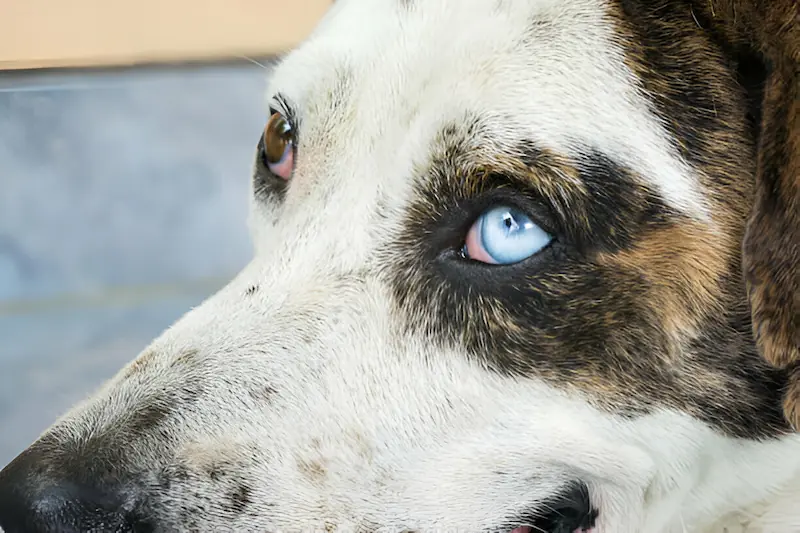what is Pannus in Dogs?
Pannus in Dogs is an eye disease that affects the third eyelid and cornea of a dog’s eyes. It can eventually lead to blindness if left untreated. Here, our South Florida veterinarians list causes signs, and treatment options for dogs affected by Pannus.
How Pannus Affects a Dog’s Eyes

Pannus (also known as chronic superficial keratitis) is a condition involving the cornea and third eyelid of a dog’s eyes. This eye disease causes a gray-pink film to cover the eye and the cornea to become dull as the disease progresses. It usually affects both eyes.
Although it is possible for chronic superficial keratitis to occur in only one eye, it most commonly affects both eyes.
Related: Turmeric For Dogs: Health Benefits You Didn’t Know
Causes of Pannus in Dogs
An exact cause of pannus has not been identified. However, it is believed to be primarily a hereditary disease that occurs as the dog grows older. Pannus is believed to be hereditary because it typically only occurs in certain breeds of dogs, although it can occur in any breed.
Although pannus is not fully understood and many are uncertain about its causes, we do know that some factors may contribute to the development of the disease. These factors include:
- Exposure to airborne irritants
- Altitude
- A large amount of sunlight
- Entropion (eyelids turned inward)
- Immune-mediated inflammation
- Underlying eye diseases
Dog Breeds Susceptible to Pannus
Middle-aged dogs (5-8 years) represent the age group most likely to develop pannus. Although any dog can develop this condition, it is commonly diagnosed in the following dog breeds:
German shepherds (make 90% of cases) and Belgian tervurens, Border collies, Greyhounds, Rhodesian ridgebacks, Siberian Huskies
Although these breeds are more likely to develop this condition, it is important to remember that any dog can develop pannus. Additionally, you should keep an eye on your dog if it is mixed with any of these breeds to see if it shows any signs of illness.
Pannus in dogs: what symptoms to Watch For

The initial symptoms of this eye disease are non-painful, raised lesions on the cornea. Although they are usually red or pink, they can also be brown or gray. These lesions are most commonly seen on the outside of the eye. The third eyelid may also become thick and inflamed. Although both eyes are usually affected, one may look worse than the other.
Other symptoms of pannus in dogs that you should be aware of may include:
- Pigmentation of the cornea
- The opacity of the cornea
- A gray-pink film on the eyes
- Tearing and redness
If your dog shows any of the above symptoms, it is better to err on the side of caution and consult a veterinary ophthalmologist.
Treatment for Pannus in Dogs
Unfortunately, pannus has no cure, and treatment will last for the rest of your pet’s life. The advantage is that with careful monitoring by a veterinarian and thorough home care by the pet owner, most dogs respond quite well to treatment.
Treatment will likely include topical corticosteroids in addition to other eye medications. In extreme cases, surgery or radiation therapy may be used to the point where more traditional methods are sufficient.
Dogs with pannus require ongoing and lifelong medication to prevent lesions from returning to the cornea. Regular eye exams are crucial to detect recurring flare-ups once the pannus is under control.
It is important to follow your veterinarian’s instructions carefully and consistently administer medications as directed. Regular checks and attention are essential as the condition is likely to recur throughout your dog’s life.
The Prognosis for Canine Pannus
For dogs that live in regions with lower UV radiation, topical treatment is often very effective in controlling pannus. However, treating patients who live in areas with brighter UV light can be a more difficult task.
It is extremely important to remember to follow the medication instructions carefully. Failure to follow detailed instructions may cause the condition to worsen over time.
Where should I go if I think my dog is having vision problems?
Dogs sometimes develop minor or serious eye diseases or infections that can affect your pup’s vision and cause pain or discomfort. While some conditions are age-related, others are illnesses or injuries.
Regardless of the problem, any suspected loss of vision or discomfort in either eye should be examined immediately by a veterinarian or veterinary ophthalmologist. Early diagnosis and treatment play a critical role in positive outcomes for your dog’s health.
Animal and VGR-certified ophthalmologists work with your pet’s veterinarian to provide the most comprehensive and compassionate eye care possible. We can diagnose and treat virtually any eye condition or disease, including dry eyes, infections, tumors, and more.
Note: The advice in this post is for informational purposes only and does not constitute medical advice regarding pets. For an accurate diagnosis of your pet’s condition, make an appointment with the veterinarian.
FAQs
How do you treat pannus in dogs?
How is the pannus treated? Treatment includes the use of topical corticosteroids (usually prednisolone or dexamethasone) or other immunomodulatory drugs such as cyclosporine. Sometimes treatment involves a steroid injection under the conjunctiva.
Is pannus in dogs life-threatening?
If pannus is discovered in its early stages, home treatment with topical medications controls the condition. Your dog will be able to carry on with life as before. If the disease has progressed, your dog may lose sight in one or, in severe cases, both eyes.
What is the best treatment for pannus?
Unfortunately, there is no cure for pannus, but the good news is that it is a treatable disease. Veterinarians usually prescribe eye drops such as dexamethasone, prednisolone, or cyclosporine to treat them. The earlier this condition is detected, the less chance there is of scar tissue or serious deterioration.
Is pannus in dogs contagious?
No, pannus is not contagious. It is an immune-mediated condition that affects individual dogs and cannot be spread to other animals or humans.
Can pannus lead to blindness?
If left untreated, pannus can progress to the point where it significantly impairs vision or causes blindness. Early detection and consistent treatment are key to preventing severe outcomes.
Are there any breeds that are immune to pannus?
While certain breeds are more predisposed to pannus, no breed is entirely immune. Regular eye check-ups are important for all dogs, especially those at higher risk.
How often should I take my dog to the vet if they have pannus?
Dogs with pannus should have regular veterinary check-ups every 3 to 6 months, or as recommended by your veterinarian, to monitor the condition and adjust treatment as needed.
Can pannus be cured completely?
There is no cure for pannus, but it can be effectively managed with consistent treatment and regular veterinary care. Many dogs live comfortable, healthy lives with proper management.

